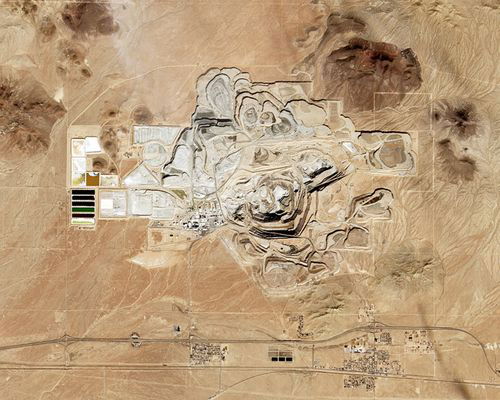This Bill Gates-backed startup will soon help power a giant mine

Heliogen, the Bill Gates-backed clean energy startup, is bringing its field of mirrors to the Mojave Desert.
In a bid to bring carbon-free power to heavy industry, Heliogen announced Wednesday that mining behemoth Rio Tinto plans to deploy the startup’s breakthrough solar technology at California’s largest open pit mine, located in Boron. Heliogen says this will be the first concentrated solar technology used to power a mine in the United States, and perhaps the world.
Heliogen will use artificial intelligence and an array of 40,000 computer-vision-controlled mirrors to harness the power of the sun, almost like a smart magnifying glass. The first system at Rio Tinto will be the size of about 100 footfall fields, Heliogen told CNN Business.
The startup says its HelioHeat technology can create extreme heat — 1,000 degrees Celsius, or about a quarter of what’s found on the surface of the sun. That’s the kind of heat required to make cement, steel and in other industrial processes like mining that typically rely on fossil fuels to power their operations.
The announcement makes Rio Tinto, the world’s second largest mining company, Heliogen’s first announced customer. The partnership is a key test of whether Heliogen’s technology can truly replace fossil fuels used to power large-scale industrial operations. And that could go a long way in fighting the climate crisis.
“It’s not that this technology was not possible before — just that it was not cost-effective,” Heliogen founder and CEO Bill Gross told CNN Business in an email. “Heliogen’s breakthrough is to make concentrated solar energy work after the sun goes down AND be cost effective compared to fossil fuel at the same time.”
The companies say the partnership will allow Rio Tinto to cut its carbon footprint — while simultaneously slashing its energy costs.
“Our goal is to deliver completely carbon free energy to Rio Tinto for less than the cost of fossil fuels and with zero emission,” Gross said.
Bringing carbon-free energy to nearly-century-old mine
Heliogen, backed by Gates and biotech billionaire Patrick Soon-Shiong, emerged from stealth mode in late 2019 by announcing a solar breakthrough. For the first time, concentrated solar energy could be used to replace fossil fuels used in industrial processes. Last year, Time magazine named Heliogen’s HelioHeat technology on its list of Best Inventions of 2020.
Now, Heliogen is teaming up with Rio Tinto on putting that technology to use.
Rio Tinto plans to use the Heliogen platform to help power the nearly-century-old California site, which mines borates, a mineral used in fertilizer, heat-resistant glass for smartphones and laptops, solar arrays and wind turbines. The mine, located in Boron, supplies almost half of the world’s demaned for refined borates, according to Rio Tinto.
Normally, the facility relies on fossil fuels to make steam. But the partnership calls for Heliogen’s AI-powered field of mirrors to generate 35,000 pounds per hour of carbon-free steam to help power the site.
The companies said the technology could cut Boron’s carbon emissions by about 7% — equal to taking more than 5,000 cars off the road. And the Heliogen system will also capture and store the clean energy to power the mine’s nighttime operations.
If this initial Heliogen installation is successful, Rio Tinto could scale up the use of the technology to reduce the site’s carbon footprint by up to 24%.
Rio Tinto is spending $1 billion to shrink its carbon footprint
The companies said they would soon begin detailed planning and securing government permits. The aim is to launch the Heliogen platform next year — and explore rolling it out to other Rio Tinto sites around the world.
The Anglo-Australian multinational hopes Heliogen will help it chip away at its goal of slashing emissions nearly in half by 2030 relative to 2010 levels. Last year, process heat, which Heliogen is providing, accounted for 14% of Rio Tinto’s direct and indirect emissions, known as Scope 1 and 2.
“This partnership with Heliogen has the potential to significantly reduce our emissions at Boron by using this groundbreaking solar technology, and we look forward to exploring opportunities across our global portfolio,” Rio Tinto CEO Jakob Stausholm said in a statement.
Rio Tinto has promised to spend about $1 billion on emissions reduction programs through 2025. The Heliogen partnership represents a multi-million dollar investment by Rio Tinto, Gross said, though the exact cost has not yet been determined.
Rio Tinto is also hoping to repair its reputation after the company destroyed a sacred Indigenous site in Australia last year. The destruction of the 46,000-year-old Juukan Gorge caves in Western Australia led to the resignation of former CEO Jean-Sébastien Jacques, who got a huge payout for 2020 nonetheless.
Using AI to fight the climate crisis
Concentrated solar power is not brand new.
This use of mirrors to reflect the sun to a single point has been used previously to generate electricity and to create heat for industry. In Oman, it is used to create carbon-free power used to drill for oil.
But Heliogen says it takes this a step further by using AI and other sophisticated technology to align thousands of mirrors to a single point, creating far hotter temperatures than were possible in the past.
Now, Heliogen must convince industrial companies like Rio Tinto to ditch fossil fuels for the sun.
“Heliogen is being bombarded with customers from all over the world,” Gross said, “from every industry ranging from metals, to cement, to utilities, to Hydrogen production.”